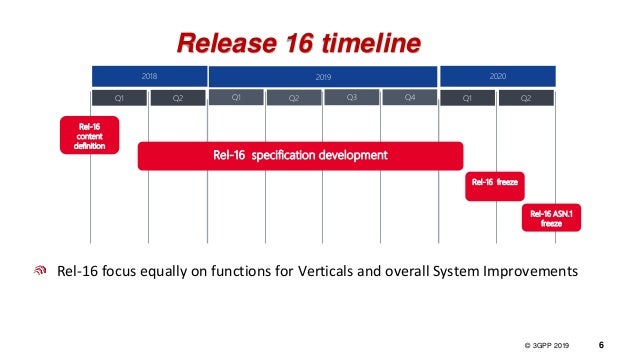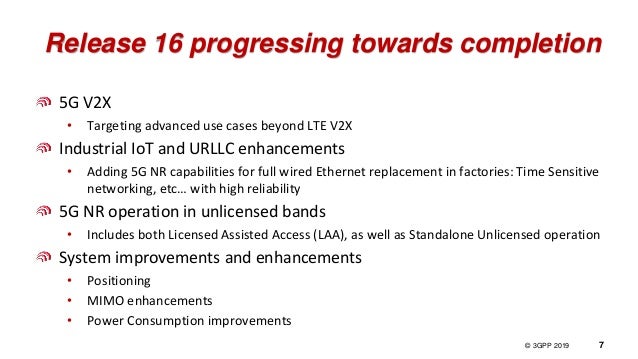Timelines for IMT 2020 (subject to change) and 3GPP Release 16
15 July 2019 Update & Clarification:
For the completion of Step 8 (see revised description below) and the finalization of the draft new Recommendation ITU-R M.[IMT‑2020.SPECS] in Working Party 5D, a completion date of the WP 5D meeting No. 36, currently planned for 7-14 October 2020 had previously been chosen.
However, this completion date has been shifted to a new WP 5D Meeting #36bis planned for 17-19 November 2020 (shown in above table). The focus of this ‘bis’ meeting is specifically the technology aspects and associated matters necessary to finalize the draft new Recommendation ITU-R M.[IMT-2020.SPECS].
This shift was done to assist the Transposing Organizations by providing them additional time to prepare their transposed standards aligned with the Global Core Specification that would be provided to WP 5D meeting #35 (24 June – 1 July 2020).
The additional time afforded by scheduling a new WP 5D Meeting #36bis as the new completion meeting of the draft new Recommendation ITU-R M.[IMT-2020.SPECS] affords the Transposing Organizations at least 13 weeks of time after WP 5D Meeting #35 to provide the Radiocommunication Bureau by the indicated due date (8 October 2020) with the relevant technical material (e.g., the URL hyperlinks) and other related administrative matters to ITU-R after the Meeting #35, in proper alignment with the GCS.
The ITU-R Secretariat, upon receipt of this material from the Transposing Organizations will administratively prepare (i.e., compile, edit, format, etc.) the final draft of the Recommendation incorporating all the technologies (RITs and SRITs) agreed by ITU-R for inclusion in Step 8 and make it available to WP 5D Meeting #36bis.
Step 8 – Development of radio interface Recommendation(s):
In this step a (set of) IMT-2020 terrestrial component radio interface Recommendation(s) is developed within the ITU-R on the basis of the results of Step 7, sufficiently detailed to enable worldwide compatibility of operation and equipment, including roaming.
This work may proceed in cooperation with relevant organizations external to ITU in order to complement the work within ITU‑R, using the principles set out in Resolution ITU-R 9-5.
Step 9 – Implementation of Recommendation(s):
In this step, activities external to ITU-R include the development of supplementary standards (if appropriate), equipment design and development, testing, field trials, type approval (if appropriate), development of relevant commercial aspects such as roaming agreements, manufacture and deployment of IMT-2020 infrastructure leading to commercial service.
……………………………………………………………………………………………………………………………………………………………………………………………………………
3GPP input to IMT 2020 RIT/SRIT and Release 16 Schedule:
3GPP notes that with the complexities of 5G as a new generation of technology and the importance of the new Recommendation ITU-R M.[IMT-2020.SPECS] globally for all stakeholders (including support for the results of WRC-19), any additional time afforded to the External Organizations in Step 8 for provision of the URL references would be of great benefit to all the radio interface technology proponents, not just 3GPP.
3GPP welcomes any accommodation WP 5D might make concerning the scheduling of the work to conclude the first release of Recommendation ITU-R M.[IMT-2020.SPECS] and kindly asks for feedback to 3GPP from that discussion.
……………………………………………………………………………………………………………………
From 3GPP Webinar – 3 July 2019:


“For the (industry) verticals, there are three distinct pillars that we are focused on: Automotive, Industrial IoT and Operation in unlicensed frequency bands.
For 5G based V2X, which builds on the two iterations of the LTE-V2X, we are now adding advanced features – primarily in the area of low latency use cases.
The second focus is industrial IoT and URLLC enhancements. Factory automation, in particular, is a strong pillar for 5G going forward. We are trying to ensure that the radio side covers all of the functions that all the verticals need for factory automation. What this means in practice is that we are trying to make sure 5G NR can fully replace a wired Ethernet – currently used – by adding time sensitive networking and high reliability capabilities.
The third pillar is operation in unlicensed bands. We have seen different schemes for generic 5G licensing strategies in Europe and in other parts of the World. We have seen in some countries that certain licensed bands have been allocated for vertical use cases, though that is not the case for a majority of countries. The use of unlicensed bands provides a great opportunity – where licensed spectrum is not an option. We are now focused on not only what we have with LTE, which is the licensed assisted access scheme, but also on standalone unlicensed operation – to be completed in Release 16.
Release 16 also delivers generic system improvements & enhancements, which target Mobile Broadband, but can also be used in vertical deployments –> Particularly: positioning, MIMO enhancements and Power consumption improvements.”
See and listen to this 3GPP Webinar at: https://vimeo.com/346171906
………………………………………………………………………………………………………………………………………………….
Annex 1. From ATIS contribution to ITU-R WP5D July 2019 meeting in Brazil:
3GPP has agreed revised completion dates for Release 16 – schedule shifted out by 3 months:
Release 16 RAN-1 Freeze RAN # 86 December 2019
Release 16 RAN Stage 3 Freeze RAN # 87 March 2020
Release 16 ASN.1 Freeze RAN # 88 June 2020
Release 16 RAN-4 Freeze RAN # 89 September 2020
……………………………………………………………………………………………………………………
Submitted on behalf of the 3GPP Proponent of the 3GPP submission, which is collectively the 3GPP Organizational Partners (OPs). The 3GPP OPs are ARIB, ATIS, CCSA, ETSI, TSDSI, TTA and TTC (http://www.3gpp.org/partners)
4 thoughts on “Timelines for IMT 2020 (subject to change) and 3GPP Release 16”
Comments are closed.







Performance Requirements for IMT 2020:
https://www.itu.int/dms_pub/itu-r/opb/rep/R-REP-M.2410-2017-PDF-E.pdf
At it’s Dec 11-13, 2019 meeting in Geneva, ITU-R WP 5D SWG Evaluation/WG Technology Aspects has determined that 3GPP, China, Korea, TSDSI (India), ETSI/DECT Forum and Nufront IMT 2020 RIT self evaluations were complete as per IMT-2020 Process Step 3.
That result progresses IMT 2020 RITs from TSDSI, ETSI-DECT Forum, Nufront (still some issued with this one) which were said to be incomplete at the previous WP 5D meeting (#32) as per this text:
“Working Party 5D (WP 5D) has so far identified at WP 5D meeting #32, in its review of the Proponent (TSDSI/ETSI-DECT Forum/Nufront), some submission deficiencies and clarification of technology issues which impact the submission and the ability of WP 5D to have the submission move forward in the IMT-2020 process. The proponent had been requested in the discussions in WP 5D meeting #32 to remedy the deficient information.”
“This submission cannot, in its current form, be determined to have satisfactorily fulfilled Section 4.3 for the self-evaluation. The supplied self-evaluation and any amendments accepted during WP 5D meeting #32 for TSDSI RIT do not yet permit WP 5D to determine if a complete and satisfactory self-evaluation as required by the IMT-2020 process has been fully provided.
The Proponent should provide the full details requested in the process and in the specifically defined way to WP 5D, considering the comments raised in WP 5D meeting #32, in order for WP 5D to proceed further in the process with this submission”
………………………………………………………………
Note that ATIS and 5GMF (Japan) stated that China and Korea IMT 2020 IMT 2020 RIT submissions are technically identical to 3GPPs which is based on 3GPP Release 15 (for both 5G-NR and NB-IoT).
As ITU-R WP5D reports to SG 5, 5D must complete IMT 2020.specs at their Nov 17-19, 2020 meeting so that they can forward it for approval to the next scheduled SG 5 meeting which takes place the following week – Nov 23,24 in Geneva. Failure to do that will result in IMT 2020.specs to not be approved by ITU-R till 2021.
The last ITU-R SG 5 meeting after WP 5D Meeting No. 36bis is Nov 23-24, 2020 in Geneva. If IMT 2020.SPECS are not been approved at that meeting, they should be renamed IMT 2021 (or perhaps IMT 2022)!
It is not possible for IMT 2020 to meet ITU-R Performance Requirements (especially ultra high reliability/ultra low latency), have a 5G Core with 5G network management, control plane/signaling, and security until 3GPP Release 16 is completed and submitted to ITU-R WP 5D at their June 2020 meeting- just 1 week after the related 3GPP June 2020 meeting has been completed.
IMT 2020 Performance Requirements:
https://www.itu.int/dms_pub/itu-r/opb/rep/R-REP-M.2410-2017-PDF-E.pdf
https://www.itu.int/en/ITU-R/study-groups/rsg5/rwp5d/imt-2020/Documents/S01-1_Requirements%20for%20IMT-2020_Rev.pdf